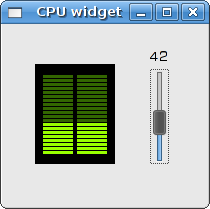GTK FAQ Custom Widget
РңР°СӮРөСҖиал РёР· Wiki.crossplatform.ru
In this part of the GTK+ programming tutorial, we will create a custom GTK+ widget, where we will use the Cairo graphics library.
CPU widget
In the next example we will create a CPU widget.
/* cpu.h */ #ifndef __CPU_H #define __CPU_H #include <gtk/gtk.h> #include <cairo.h> G_BEGIN_DECLS #define GTK_CPU(obj) GTK_CHECK_CAST(obj, gtk_cpu_get_type (), GtkCpu) #define GTK_CPU_CLASS(klass) GTK_CHECK_CLASS_CAST(klass, gtk_cpu_get_type(), GtkCpuClass) #define GTK_IS_CPU(obj) GTK_CHECK_TYPE(obj, gtk_cpu_get_type()) typedef struct _GtkCpu GtkCpu; typedef struct _GtkCpuClass GtkCpuClass; struct _GtkCpu { GtkWidget widget; gint sel; }; struct _GtkCpuClass { GtkWidgetClass parent_class; }; GtkType gtk_cpu_get_type(void); void gtk_cpu_set_sel(GtkCpu *cpu, gint sel); GtkWidget * gtk_cpu_new(); G_END_DECLS #endif /* __CPU_H */
/* cpu.c */ #include "cpu.h" static void gtk_cpu_class_init(GtkCpuClass *klass); static void gtk_cpu_init(GtkCpu *cpu); static void gtk_cpu_size_request(GtkWidget *widget, GtkRequisition *requisition); static void gtk_cpu_size_allocate(GtkWidget *widget, GtkAllocation *allocation); static void gtk_cpu_realize(GtkWidget *widget); static gboolean gtk_cpu_expose(GtkWidget *widget, GdkEventExpose *event); static void gtk_cpu_paint(GtkWidget *widget); static void gtk_cpu_destroy(GtkObject *object); GtkType gtk_cpu_get_type(void) { static GtkType gtk_cpu_type = 0; if (!gtk_cpu_type) { static const GtkTypeInfo gtk_cpu_info = { "GtkCpu", sizeof(GtkCpu), sizeof(GtkCpuClass), (GtkClassInitFunc) gtk_cpu_class_init, (GtkObjectInitFunc) gtk_cpu_init, NULL, NULL, (GtkClassInitFunc) NULL }; gtk_cpu_type = gtk_type_unique(GTK_TYPE_WIDGET, >k_cpu_info); } return gtk_cpu_type; } void gtk_cpu_set_state(GtkCpu *cpu, gint num) { cpu->sel = num; gtk_cpu_paint(GTK_WIDGET(cpu)); } GtkWidget * gtk_cpu_new() { return GTK_WIDGET(gtk_type_new(gtk_cpu_get_type())); } static void gtk_cpu_class_init(GtkCpuClass *klass) { GtkWidgetClass *widget_class; GtkObjectClass *object_class; widget_class = (GtkWidgetClass *) klass; object_class = (GtkObjectClass *) klass; widget_class->realize = gtk_cpu_realize; widget_class->size_request = gtk_cpu_size_request; widget_class->size_allocate = gtk_cpu_size_allocate; widget_class->expose_event = gtk_cpu_expose; object_class->destroy = gtk_cpu_destroy; } static void gtk_cpu_init(GtkCpu *cpu) { cpu->sel = 0; } static void gtk_cpu_size_request(GtkWidget *widget, GtkRequisition *requisition) { g_return_if_fail(widget != NULL); g_return_if_fail(GTK_IS_CPU(widget)); g_return_if_fail(requisition != NULL); requisition->width = 80; requisition->height = 100; } static void gtk_cpu_size_allocate(GtkWidget *widget, GtkAllocation *allocation) { g_return_if_fail(widget != NULL); g_return_if_fail(GTK_IS_CPU(widget)); g_return_if_fail(allocation != NULL); widget->allocation = *allocation; if (GTK_WIDGET_REALIZED(widget)) { gdk_window_move_resize( widget->window, allocation->x, allocation->y, allocation->width, allocation->height ); } } static void gtk_cpu_realize(GtkWidget *widget) { GdkWindowAttr attributes; guint attributes_mask; g_return_if_fail(widget != NULL); g_return_if_fail(GTK_IS_CPU(widget)); GTK_WIDGET_SET_FLAGS(widget, GTK_REALIZED); attributes.window_type = GDK_WINDOW_CHILD; attributes.x = widget->allocation.x; attributes.y = widget->allocation.y; attributes.width = 80; attributes.height = 100; attributes.wclass = GDK_INPUT_OUTPUT; attributes.event_mask = gtk_widget_get_events(widget) | GDK_EXPOSURE_MASK; attributes_mask = GDK_WA_X | GDK_WA_Y; widget->window = gdk_window_new( gtk_widget_get_parent_window (widget), & attributes, attributes_mask ); gdk_window_set_user_data(widget->window, widget); widget->style = gtk_style_attach(widget->style, widget->window); gtk_style_set_background(widget->style, widget->window, GTK_STATE_NORMAL); } static gboolean gtk_cpu_expose(GtkWidget *widget, GdkEventExpose *event) { g_return_val_if_fail(widget != NULL, FALSE); g_return_val_if_fail(GTK_IS_CPU(widget), FALSE); g_return_val_if_fail(event != NULL, FALSE); gtk_cpu_paint(widget); return FALSE; } static void gtk_cpu_paint(GtkWidget *widget) { cairo_t *cr; cr = gdk_cairo_create(widget->window); cairo_translate(cr, 0, 7); cairo_set_source_rgb(cr, 0, 0, 0); cairo_paint(cr); gint pos = GTK_CPU(widget)->sel; gint rect = pos / 5; cairo_set_source_rgb(cr, 0.2, 0.4, 0); gint i; for ( i = 1; i <= 20; i++) { if (i > 20 - rect) { cairo_set_source_rgb(cr, 0.6, 1.0, 0); } else { cairo_set_source_rgb(cr, 0.2, 0.4, 0); } cairo_rectangle(cr, 8, i*4, 30, 3); cairo_rectangle(cr, 42, i*4, 30, 3); cairo_fill(cr); } cairo_destroy(cr); } static void gtk_cpu_destroy(GtkObject *object) { GtkCpu *cpu; GtkCpuClass *klass; g_return_if_fail(object != NULL); g_return_if_fail(GTK_IS_CPU(object)); cpu = GTK_CPU(object); klass = gtk_type_class(gtk_widget_get_type()); if (GTK_OBJECT_CLASS(klass)->destroy) { (* GTK_OBJECT_CLASS(klass)->destroy) (object); } }
/* main.c */ #include "cpu.h" static void set_value(GtkWidget * widget, gpointer data) { GdkRegion *region; GtkRange *range = (GtkRange *) widget; GtkWidget *cpu = (GtkWidget *) data; GTK_CPU(cpu)->sel = gtk_range_get_value(range); region = gdk_drawable_get_clip_region(cpu->window); gdk_window_invalidate_region(cpu->window, region, TRUE); gdk_window_process_updates(cpu->window, TRUE); } int main (int argc, char ** argv) { GtkWidget *window; GtkWidget *cpu; GtkWidget *fixed; GtkWidget *scale; gtk_init(&argc, &argv); window = gtk_window_new(GTK_WINDOW_TOPLEVEL); gtk_window_set_title(GTK_WINDOW(window), "CPU widget"); gtk_window_set_position(GTK_WINDOW(window), GTK_WIN_POS_CENTER); gtk_window_set_default_size(GTK_WINDOW(window), 200, 180); g_signal_connect(G_OBJECT(window), "destroy", G_CALLBACK(gtk_main_quit), NULL); fixed = gtk_fixed_new(); gtk_container_add(GTK_CONTAINER(window), fixed); cpu = gtk_cpu_new(); gtk_fixed_put(GTK_FIXED(fixed), cpu, 30, 40); scale = gtk_vscale_new_with_range(0.0, 100.0, 1.0); gtk_range_set_inverted(GTK_RANGE(scale), TRUE); gtk_scale_set_value_pos(GTK_SCALE(scale), GTK_POS_TOP); gtk_widget_set_size_request(scale, 50, 120); gtk_fixed_put(GTK_FIXED(fixed), scale, 130, 20); g_signal_connect(G_OBJECT(scale), "value_changed", G_CALLBACK(set_value), (gpointer) cpu); gtk_widget_show(cpu); gtk_widget_show(fixed); gtk_widget_show_all(window); gtk_main(); return 0; }
The CPU widget is a GtkWidget, on which we draw with Cairo API. We draw a black background and 40 small rectangles. The rectangles are drawn in two colors. Dark green and bright green color. The GtkVScale widget controls the number of the bright green rectangles drawn on the widget.
The example might look difficult at the first sight. But it is not that difficult after all. Most of the code is boilerplate, it always repeats, when we create a new widget.
The drawing is done within the gtk_cpu_paint() function.
cairo_t *cr; cr = gdk_cairo_create(widget->window); cairo_translate(cr, 0, 7); cairo_set_source_rgb(cr, 0, 0, 0); cairo_paint(cr);
As usual, we create a cairo context. We shift the origin 7 unit down. Next we paint the background of the widget to black color.
gint pos = GTK_CPU(widget)->sel; gint rect = pos / 5;
Here we retrieve the sel number. It is the number that we got from the scale widget. The slider has 100 numbers. The rect parameter makes a convertion from slider values into rectangles, that will be drawn in bright green color.
gint i; for ( i = 1; i <= 20; i++) { if (i > 20 - rect) { cairo_set_source_rgb(cr, 0.6, 1.0, 0); } else { cairo_set_source_rgb(cr, 0.2, 0.4, 0); } cairo_rectangle(cr, 8, i*4, 30, 3); cairo_rectangle(cr, 42, i*4, 30, 3); cairo_fill(cr); }
Depending on the rect number, we draw 40 rectangles in two dark green color or in bright green color. Remember, that we are drawing these rectangles from top to bottom.
GtkRange *range = (GtkRange *) widget; GtkWidget *cpu = (GtkWidget *) data; GTK_CPU(cpu)->sel = gtk_range_get_value(range);
In the set_value() call, we get the reference to the CPU widget and set the sel value to current value, selected on the scale widget.
GdkRegion *region; ... region = gdk_drawable_get_clip_region(cpu->window); gdk_window_invalidate_region(cpu->window, region, TRUE); gdk_window_process_updates(cpu->window, TRUE);
This code invalides the complete window of the CPU widget and thus makes it redraw itself.

